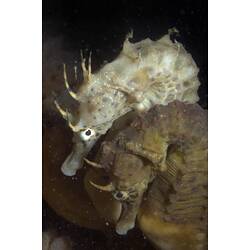General Description
A long and slender seahorse with a pot belly. The body is encased in bony rings. The tail is broadly-banded and used for grasping (it is prehensile). The head is small and at right angles to the body. The snout is long and tubular. There are often long filaments on the head and 23-31 rays on the dorsal (back) fin. Colour is variable, ranging from almost white to yellow, orange, grey, reddish and brown. Sides are generally paler with irregular black spots on the trunk and head. Individuals living in shallow bays tend to be brownish with lots of dark spots. Spines on body become smaller with growth. This is the largest seahorse known in Australia with a total length up to 35 cm.
Biology
Bigbelly Seahorses are often seen clinging to macroalgae, seagrasses and sponges to which individuals match their colour. They feed on small invertebrates, which they suck up into their mouth located at the end of their snout. Their eyes move separately, helping to locate predators and prey. They swim with a vertical posture using their dorsal fin for movement. Males have an elaborate courtship display, brightening their pouches and repeatedly inflating and deflating them. Females deposit their eggs into a male's pouch located under the abdomen. Males then fertilise and brood the eggs. Larvae are born after four weeks. Males can brood between 300 and 700 eggs per clutch and can incubate up to 4 clutches during summer. Breeding can occur year-round but peaks during warmer months.
Distribution
Eastern and southern Australia.
Habitat
Found in a range of habitats including seagrass beds and sponge gardens in bays and sheltered coastal waters and from low rocky reefs in shallow estuaries to deep tidal channels and deeper coastal reefs to a depth of 100 m.
More Information
-
Animal Type
-
Animal SubType
-
Brief Id
A large seahorse with a long, coiled tail and a pot belly.
-
Maximum Size
35 cm
-
Habitats
-
Diet
Invertebrates
-
Diet Categories
Crustaceans, Plankton
-
Endemicity
-
Commercial
No
-
Conservation Statuses
CITES: Trade restrictions (Appendix II), FFG Threatened List: Not listed, Fisheries Act 1995: Protected Aquatic Biota, EPBC Act 1999: Not listed, IUCN Red List: Least Concern
-
Depths
Shallow (1-30 m), Deep ( > 30 m)
-
Water Column Locations
On or near seafloor
-
Taxon Name
-
Scientific Author
Lesson, 1827
-
Common Name
Bigbelly Seahorse
-
Other Names
Potbelly Seahorse
-
Kingdom
-
Phylum
-
Subphylum
-
Superclass
-
Class
-
Order
-
Suborder
-
Family
-
Genus
-
Species Name
abdominalis







